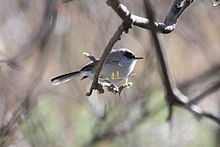Black-capped gnatcatcher
| Black-capped gnatcatcher | |
|---|---|
 | |
| Polioptila nigriceps restricta, a male in Arizona, USA | |
| Conservation status | |
| Scientific classification | |
| Kingdom: | Animalia |
| Phylum: | Chordata |
| Class: | Aves |
| Order: | Passeriformes |
| Family: | Polioptilidae |
| Genus: | Polioptila |
| Species: | P. nigriceps |
| Binomial name | |
| Polioptila nigriceps (Baird, 1864) | |
The black-capped gnatcatcher (Polioptila nigriceps) is a very small songbird.
Adults are blue-grey on the upperparts with white underparts, with a long slender bill and a long black tail with white outer tailbands on the uppertail. The undertail is extensively white, showing black only along a thin vertical center line and at the very tip. Males show a prominent black cap. This species is very similar to the California gnatcatcher and the black-tailed gnatcatcher.
Their breeding habitat occurs in riparian woodlands of western and northwestern Mexico. It has occasionally nested just across the border in southernmost Arizona, (the Madrean sky islands area), of the United States where it is infrequently found in the summer. They build a small cup nest most often in a horizontal limb of a small tree or shrub. Both parents construct the nest and feed the young. The female normally lays 4 eggs.
These birds are primarily non-migratory, remaining in breeding territories year round.
They forage actively in trees or shrubs, mainly eating insects. They may hover over foliage-(gleaning), or fly to catch insects in flight-(hawking).
References
- ↑ BirdLife International (2012). "Polioptila nigriceps". IUCN Red List of Threatened Species. Version 2013.2. International Union for Conservation of Nature. Retrieved 26 November 2013.
